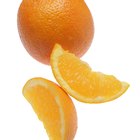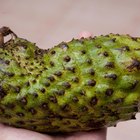
Tamarind paste is a classic Thai and Indian ingredient that can be hard to source stateside. The sour flavor of tamarind is integral to the popular Thai dish called pad Thai, and is used to flavor many curries and sauces throughout Asia. If you can't find tamarind concentrate, you can achieve a similar flavor profile using substitutes more commonly available.
Tamarind Concentrate Basics
Derived from the pulp inside the tamarind's bean-like pods, tamarind concentrate is a paste-like ingredient that when used sparingly adds a lot of sour flavor to a dish. Commonly found at Thai, Indian, Hispanic and Latino grocery stores, tamarind concentrate can be labeled as either tamarind paste or concentrate. Because tamarind is an acidic ingredient, only use it with nonreactive containers and utensils to avoid a metallic taste in your finished food.
Tamarind Pulp
The best substitute for tamarind concentrate is tamarind pulp, though this will require much more work than using the paste or concentrate. Pulp is sold in dried, hardened blocks and must be reconstituted to use in your recipe. Break off a walnut-sized piece of the pulp and soak it in 1/2 cup of warm water until you are able to break the pulp apart with your fingers. Mash the pulp well into the water until it gives the liquid a dirty brown appearance. Use a fine mesh strainer to remove the pulp and its fibers from the liquid, pressing it to extract as much liquid as possible. This preparation yields the equivalent of 1 teaspoon of tamarind concentrate.
Lime Juice
Lime juice is a widely available substitute for tamarind concentrate, though it does not provide the same tartness or sweetness as the tamarind. Amend this by mixing lime juice with equal parts of water and brown sugar or white sugar when substituting for tamarind in your recipes to create a balanced sweet and sour flavor. Only use lime juice as a substitute when a small amount of tamarind concentrate is called for, as otherwise it will change the overall flavor of the finished food. Use up to two tablespoons of the lime juice-water mixture for each teaspoon of tamarind concentrate required in a recipe.
Dried Fruits and Lemon Juice
Make a mixture using an equal part of dried fruit such as prunes, dates or apricots and lemon juice to provide a viable substitute for the sweet and sour flavor of tamarind concentrate. Blend the dried fruit and lemon juice together in a food processor or blender to create a thick paste that can be used as a 1:1 substitute in any recipe calling for tamarind paste. While this does not have the same pungent sour note as tamarind, the fruit inclusion gives the mixture a lot of depth and makes it work in a number of dishes.
Related Articles

Cooking Substitute for Tamarind ...

What Is a Good Substitute for ...

Baking Substitution for Rosewater

What Can I Substitute for the Flavor of ...

What Is a Good Substitute for Cherries?

What Is a Substitute for Cherry Liqueur?

How to make Orange Extract

Candied Fruit for Baking

Substitutes for the Saffron Spice
Substitutes for Lemon or Orange Peel

What to Substitute for Mirin

How to Make a Fruit Reduction

Can Lemon Extract Be Used in Place of ...

Brandy Flavoring Substitute

Garam Masala Substitute

How to Make Soursop Juice

Brandy vs. Whiskey

How to Use Dill Weed

How to Use Echinacea to Treat Acne
How to Substitute Chia for Xanthan Gum
References
Writer Bio
Based in Portland, Ore., Maxine Wallace is a writer with more than 12 years of experience. With a bachelor's degree in journalism and experience working on marketing campaigns for large media agencies, she is well-versed in multiple industries including the Internet, cooking, gardening, health, fitness, travel and holistic living.
Photo Credits
Medioimages/Photodisc/Photodisc/Getty Images